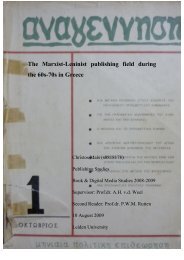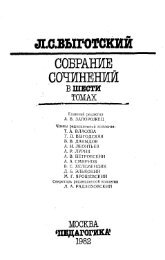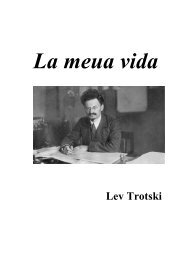Selected Works of Karl Marx
Selected Works of Karl Marx
Selected Works of Karl Marx
- No tags were found...
You also want an ePaper? Increase the reach of your titles
YUMPU automatically turns print PDFs into web optimized ePapers that Google loves.
The Paris CommuneAddress to the International Workingmen’sAssociation, May 1871On the dawn <strong>of</strong> March 18, Paris arose to the thunder-burst <strong>of</strong> “Vive la Commune!” What is theCommune, that sphinx so tantalizing to the bourgeois mind?“The proletarians <strong>of</strong> Paris,” said the Central Committee in its manifesto <strong>of</strong> March 18, “amidstthe failures and treasons <strong>of</strong> the ruling classes, have understood that the hour has struck for themto save the situation by taking into their own hands the direction <strong>of</strong> public affairs.... They haveunderstood that it is their imperious duty, and their absolute right, to render themselves masters<strong>of</strong> their own destinies, by seizing upon the governmental power.”But the working class cannot simply lay hold <strong>of</strong> the ready-made state machinery, andwield it for its own purposes.The centralized state power, with its ubiquitous organs <strong>of</strong> standing army, police, bureaucracy,clergy, and judicature – organs wrought after the plan <strong>of</strong> a systematic and hierarchic division <strong>of</strong>labor – originates from the days <strong>of</strong> absolute monarchy, serving nascent bourgeois society as amighty weapon in its struggle against feudalism. Still, its development remained clogged by allmanner <strong>of</strong> medieval rubbish, seignorial rights, local privileges, municipal and guild monopolies,and provincial constitutions. The gigantic broom <strong>of</strong> the French Revolution <strong>of</strong> the 18th centuryswept away all these relics <strong>of</strong> bygone times, thus clearing simultaneously the social soil <strong>of</strong> itslast hindrances to the superstructure <strong>of</strong> the modern state edifice raised under the First Empire,itself the <strong>of</strong>fspring <strong>of</strong> the coalition wars <strong>of</strong> old semi-feudal Europe against modern France.During the subsequent regimes, the government, placed under parliamentary control – that is,under the direct control <strong>of</strong> the propertied classes – became not only a hotbed <strong>of</strong> huge nationaldebts and crushing taxes; with its irresistible allurements <strong>of</strong> place, pelf, and patronage, it becamenot only the bone <strong>of</strong> contention between the rival factions and adventurers <strong>of</strong> the ruling classes;but its political character changed simultaneously with the economic changes <strong>of</strong> society. At thesame pace at which the progress <strong>of</strong> modern industry developed, widened, intensified the classantagonism between capital and labor, the state power assumed more and more the character <strong>of</strong>the national power <strong>of</strong> capital over labor, <strong>of</strong> a public force organized for social enslavement, <strong>of</strong>an engine <strong>of</strong> class despotism.After every revolution marking a progressive phase in the class struggle, the purely repressivecharacter <strong>of</strong> the state power stands out in bolder and bolder relief. The Revolution <strong>of</strong> 1830,resulting in the transfer <strong>of</strong> government from the landlords to the capitalists, transferred it fromthe more remote to the more direct antagonists <strong>of</strong> the working men. The bourgeois republicans,who, in the name <strong>of</strong> the February Revolution, took the state power, used it for the June [1848]massacres, in order to convince the working class that “social” republic means the republicentrusting their social subjection, and in order to convince the royalist bulk <strong>of</strong> the bourgeois andlandlord class that they might safely leave the cares and emoluments <strong>of</strong> government to thebourgeois “republicans.”However, after their one heroic exploit <strong>of</strong> June, the bourgeois republicans had, from the front, t<strong>of</strong>all back to the rear <strong>of</strong> the “Party <strong>of</strong> Order” – a combination formed by all the rival fractions andfactions <strong>of</strong> the appropriating classes. The proper form <strong>of</strong> their joint-stock government was theparliamentary republic, with Louis Bonaparte for its president. Theirs was a regime <strong>of</strong> avowedclass terrorism and deliberate insult towards the “vile multitude.”If the parliamentary republic, as M. Thiers said, “divided them [the different fractions <strong>of</strong> theruling class] least,” it opened an abyss between that class and the whole body <strong>of</strong> society outsidetheir spare ranks. The restraints by which their own divisions had under former regimes stillchecked the state power, were removed by their union; and in view <strong>of</strong> the threatening upheaval














![tyf Enf=O=n]lgg](https://img.yumpu.com/47584932/1/190x245/tyf-enfonlgg.jpg?quality=85)

